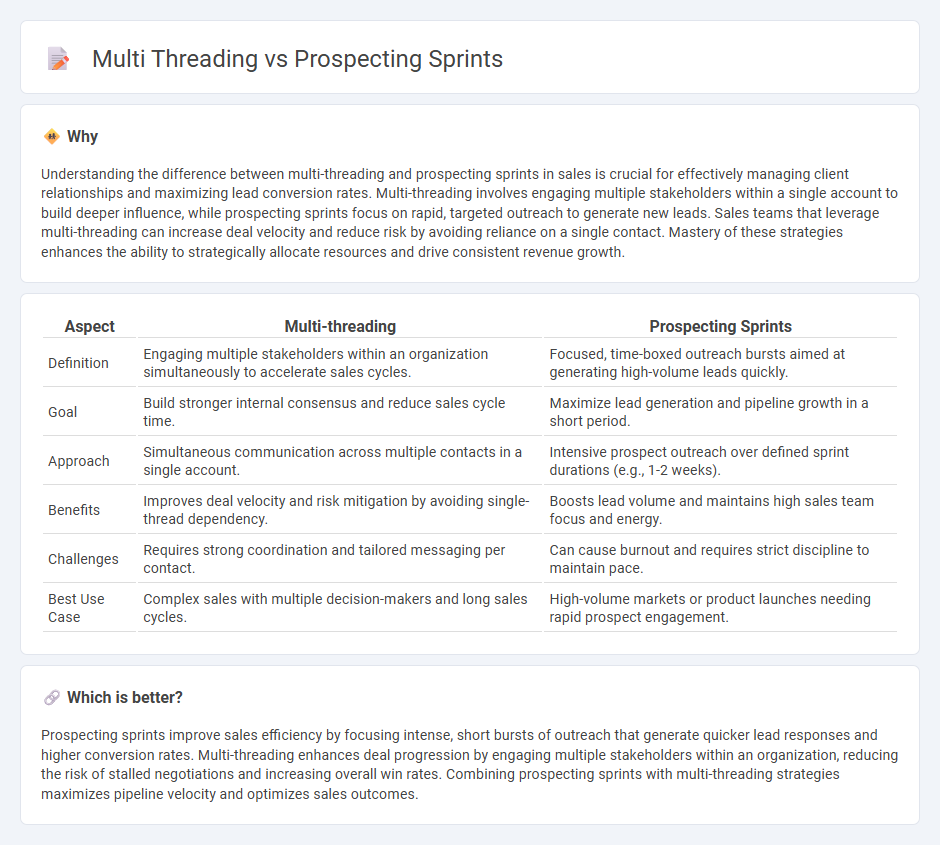
Multi-threading enhances sales effectiveness by engaging multiple stakeholders within a prospect's organization simultaneously, increasing the chances of closing deals faster. Prospecting sprints focus on short, intense efforts to identify and qualify leads rapidly, driving pipeline growth through concentrated outreach. Discover how integrating multi-threading with prospecting sprints can accelerate your sales process and boost conversion rates.
Why it is important
Understanding the difference between multi-threading and prospecting sprints in sales is crucial for effectively managing client relationships and maximizing lead conversion rates. Multi-threading involves engaging multiple stakeholders within a single account to build deeper influence, while prospecting sprints focus on rapid, targeted outreach to generate new leads. Sales teams that leverage multi-threading can increase deal velocity and reduce risk by avoiding reliance on a single contact. Mastery of these strategies enhances the ability to strategically allocate resources and drive consistent revenue growth.
Comparison Table
| Aspect | Multi-threading | Prospecting Sprints |
|---|---|---|
| Definition | Engaging multiple stakeholders within an organization simultaneously to accelerate sales cycles. | Focused, time-boxed outreach bursts aimed at generating high-volume leads quickly. |
| Goal | Build stronger internal consensus and reduce sales cycle time. | Maximize lead generation and pipeline growth in a short period. |
| Approach | Simultaneous communication across multiple contacts in a single account. | Intensive prospect outreach over defined sprint durations (e.g., 1-2 weeks). |
| Benefits | Improves deal velocity and risk mitigation by avoiding single-thread dependency. | Boosts lead volume and maintains high sales team focus and energy. |
| Challenges | Requires strong coordination and tailored messaging per contact. | Can cause burnout and requires strict discipline to maintain pace. |
| Best Use Case | Complex sales with multiple decision-makers and long sales cycles. | High-volume markets or product launches needing rapid prospect engagement. |
Which is better?
Prospecting sprints improve sales efficiency by focusing intense, short bursts of outreach that generate quicker lead responses and higher conversion rates. Multi-threading enhances deal progression by engaging multiple stakeholders within an organization, reducing the risk of stalled negotiations and increasing overall win rates. Combining prospecting sprints with multi-threading strategies maximizes pipeline velocity and optimizes sales outcomes.
Connection
Multi-threading enhances sales effectiveness by engaging multiple decision-makers within a single prospect simultaneously, increasing the likelihood of successful deals. Prospecting sprints complement this approach by concentrating outreach efforts into focused, time-bound campaigns that maximize lead generation and momentum. Combining multi-threading with prospecting sprints accelerates pipeline growth and shortens sales cycles through coordinated, high-intensity engagement.
Key Terms
Lead Generation
Prospecting sprints concentrate on short, intensive bursts of lead generation activities designed to quickly identify high-potential prospects, maximizing efficiency in targeting decision-makers. Multi-threading in lead generation involves simultaneously engaging multiple stakeholders within a single organization to increase conversion rates and build stronger relationships. Explore effective strategies for balancing prospecting sprints and multi-threading to optimize your lead generation outcomes.
Account Penetration
Prospecting sprints concentrate on rapid, focused outreach to specific accounts, maximizing account penetration by intensifying efforts within short, defined timeframes. Multi-threading in sales involves engaging multiple stakeholders within the target account simultaneously, increasing the chances of securing buy-in and deepening account relationships. Explore detailed strategies to effectively combine both approaches for optimal account penetration results.
Decision Maker Engagement
Prospecting sprints involve concentrated bursts of outreach targeting decision makers to maximize engagement efficiency and response rates. In contrast, multi-threading employs simultaneous contact points across different stakeholders within the same organization to increase touchpoints and influence the decision-making process. Explore these strategies further to optimize your sales engagement and boost conversion rates.
Source and External Links
Gaining Industry Insights: The Value of Prospecting Sprints - Prospecting sprints are focused, six-week cycles targeting one market to build momentum, set specific call/email goals, mine leads, and develop playbooks, which help gain insights into industry sales cycles and buying processes.
3 Guiding Principles of Sprint Prospecting - Sprint prospecting emphasizes agility, authentic value delivery, thorough research, and reciprocity to engage prospects effectively amid changing market conditions.
White Paper: Accessing Growth with Sprint Prospecting - Sprint prospecting consists of short, intense bursts focused on customer conversations using authenticity, research, and reciprocity to craft ultra-customized messaging and build ongoing communication cadence.
 dowidth.com
dowidth.com